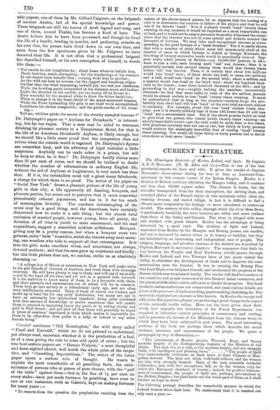CURRENT LITERATURE.
The Himalayan Districts of Kooloo, Lahoul, and Spat. By Captain A. F. P. Harcourt. (W. H. Allen and Co.)—This is one of the best provincial reports we have met with. It gives the results of Captain Harcourt's observations during his tour of duty as Assistant-Com- missioner in this remote corner of the Indian Empire. Kooloo is a district of British territory adjoining the Kangra valley, and it contains not less than 10,000 square miles. The climate is warm, but the traveller transported from the fiery atmosphere, the driving dust, and scorched plains of the Punjab enjoys in this mountain valley clear air, running streams, and varied foliage, in fact it is difficult to find a climate more congenial to the feelings or more calculated to restore an invalid. The scenery of this valley, through which the river Bess flows, is particularly beautiful, the river terraces are wider and more verdant than those of the Sutlej and Chenab. The river is fringed with trees and studded with green islands. Kooloo has the advantage of being traversed by a good road. The districts of Spiti and Lahoul, separated from Kook* by the Hampta and Rotang passes, are smaller, and not so favoured by nature either as to beauty or fertility, but they are inhabited by an interesting and independent race of people. The religion, language, and peculiar customs of the district are described by Captain Harcourt in successive chapters. The commerce that finds its. way between the Punjab and East Turkistan chiefly passes through Kooloo and Lahoul, and two Viceroys have of late years visited the valley, to stimulate the development of trade and to improve the com- munications near the frontier. It was in crossing the Rotang Pass that Lord Elgin over-fatigued himself, and accelerated the progress of the disease which soon terminated fatally. The reader will find here notices of the countries and people concerned in this Central Asian commerce, and the physical difficulties which still exist to hinder its progress. The local products and manufactures are enumerated, and some curious details are given of the processes of basket-making, paper-making, thatching, &c. The materials employed are obscure or litte known. In Kooloo the energy and sillk of the European tea-planter are producing a great change in the aspect of this naturally fertile valley. Here, too, the facts given show deci- sively how urgently the formation of the Forest Department was required to introduce correct principles of conservancy and cutting, and to preserve the forests of the Himalaya from the ruinous waste to which they have been subjected in past years. The most interesting portions of the book are perhaps those which describe the social customs, manners, and amusements of the people. We quote a paragraph by way of illustration :— " The inhabitants of Kooloo proper, Wuzeeri, Rupi, and Seoraj partake largely of the distinguishing features of the Hindoos of the plains. The men are, as a rule, of the medium height, and are strongly built, with intelligent and pleasing faces." "The people of Spiti bear unmistakable evidences on their faces of their Chinese or Mon- golian descent. The men are stout, well-built fellows, and the women are also very strongly framed. Many of the men resemble veritable Calmucks; and, with few exceptions, fall, as do the women, very far below the European standard of beauty; indeed, for positive hideous- ness of countenance, the people of Spiti are, perhaps, pre-eminent in the British Empire ; but their looks are the worst part of them, as I shall further on hope to show."
The following passage describes the remarkable manner in which the Lahonl women dross their hair. We understand that it is combed out only once a year :— " The hair of the Lahoulee women is twisted in numerous braids, and these are gathered together at the back and fastened either into a scallop-shell or strung to beads, and, on the crown of the head, that is always bare, a small and rather elegantly-chased saucer of silver is affixed; this is set round in the inside with coral and turquoise, gar- nished with gold, and occasionally on the forehead a rough specimen of turquoise is secured into the hair. The dress is a long black woollen garment, fastened by a waistcloth ; thick trousers of the same material, and grass shoes, completing the attire. Necklaces and earrings of amber and rough stones are also common."
'The hook contains some good representations of the Kooloo people. One figure we distinctly recognise after a lapse of nine years.



































 Previous page
Previous page